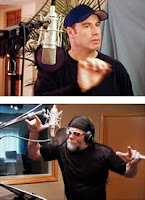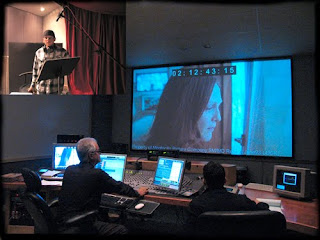 By Dan Parkes (Director)
By Dan Parkes (Director)ADR stands for "Automated Dialogue Replacement" and is the dubbing or re-recording of dialogue during post-production. Apparently in the UK it is called "post-synchronisation" or "post-sync".
This process is normally required due to technical issues such as poor on-location sound or interference. It can sometimes also be a creative choice -adding extra dialogue to make a scene make more sense. Or sometimes for creating different versions due to classification issues. Samuel L. Jackson famously had his key piece of dialogue from "Snakes on a Plane" rerecorded to replace the offensive language resulting in the dubbed version in he which says "monkey fighting snakes on this Monday to Friday plane"!
Sometimes up to a third or more of film can end up being rerecorded via ADR. However some directors such as Chris Nolan are well known for insisting on using on-location sound only, as quite often ADR -despite the best recordings- never rings true. So it certainly is best to avoid if at all possible.
 ADR sessions mostly take place in a recording studio with the original actor watching a looped playback of the shot and then trying to recreate the necessary dialogue. For Ambleton Delight we created a similar process, although it was recorded in a living room. Here are some tips we learned along the way....
ADR sessions mostly take place in a recording studio with the original actor watching a looped playback of the shot and then trying to recreate the necessary dialogue. For Ambleton Delight we created a similar process, although it was recorded in a living room. Here are some tips we learned along the way....- It really must be a last resort -despite the best efforts it will never match the real thing! Get it right on location as much as possible.
- Don't just record the word or sentence as it most likely will be too difficult to match the feel of the original dialogue. Record the entire scene or as much of it as possible, to ensure audio continuity.
- Treat ADR the same as when directing actors on set -give as much or as little direction, back-story, motivation as required.
- Have the actor move around to imitate the body positions on the screen -especially if it involves walking, running or jumping, as this affects the tone and breathing
- Use the same or as similar microphones as was used to record the original dialogue. Don't use a voice over microphone unless you need that effect.
- If recording in a non-studio location be aware of acoustics and reverb and try to match or simulate what the original environment was like.
- Provide a visual reference -a TV monitor or laptop. Beware that some TVs and laptops make high frequency noise that could affect the recording
- Loop the scene, with both video and audio continually repeating for at least three times, then the fourth is silent allowing the actor to fill in the audio.
- Have a visual or audio cue so the actor knows when the looping piece begins so they can time when to start.
- Do it in small sections. Don't expect an actor to be able to match precise mouth movements over several sentences. But balance this with the need for momentum and being "in-character".
- Not every word has to be exactly in-sync. Some timing can be assisted through audio editing -but of course better to get it as close as you can during the ADR session.






No comments:
Post a Comment